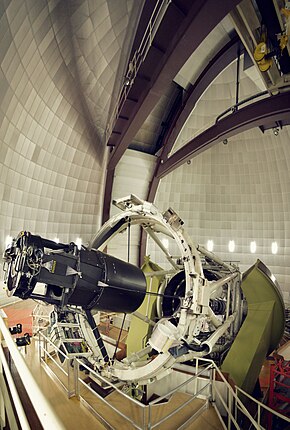 | |
| Part of | Australian Astronomical Observatory Siding Spring Observatory |
|---|---|
| Location(s) | New South Wales, AUS |
| Coordinates | 31°16′31″S 149°04′01″E / 31.2754°S 149.067°E |
| Organization | Australian Astronomical Observatory |
| Altitude | 1,100 m (3,600 ft) |
| Built | –1974 |
| First light | 27 April 1974 |
| Telescope style | Cassegrain reflector optical telescope |
| Diameter | 3.9 m (12 ft 10 in) |
| Collecting area | 12 m2 (130 sq ft) |
| Focal length | 12.7 m (41 ft 8 in) |
| Enclosure | spherical dome |
| Website | www |
| | |
The Anglo-Australian Telescope (AAT) is a 3.9-metre equatorially mounted telescope operated by the Australian Astronomical Observatory and situated at the Siding Spring Observatory, Australia, at an altitude of a little over 1,100 m. In 2009, the telescope was ranked as having the fifth-highest-impact of the world's optical telescopes. In 2001–2003, it was considered the most scientifically productive 4-metre-class optical telescope in the world based on scientific publications using data from the telescope.[1][2]
The telescope was commissioned in 1974 with a view to allowing high-quality observations of the sky from the Southern Hemisphere. At the time, most major telescopes were located in the Northern Hemisphere, leaving the southern skies poorly observed.[3] It was the largest telescope in the Southern Hemisphere from 1974 to 1976, then a close second to the Víctor M. Blanco Telescope from 1976 until 1998, when the first ESO Very Large Telescope (VLT) was opened. The AAT was credited with stimulating a resurgence in British optical astronomy.[3] It was built by the United Kingdom in partnership with Australia but has been entirely funded by Australia since 2010.[4] Observing time is available to astronomers worldwide.
The AAT was one of the last large telescopes built with an equatorial mount. More recent large telescopes have instead adopted the more compact and mechanically stable altazimuth mount. The AAT was, however, one of the first telescopes to be fully computer-controlled, and set new standards for pointing and tracking accuracy.
- ^ Watson, Fred (6 January 2009). "Across the universe". The Sydney Morning Herald. Retrieved 8 November 2011.
- ^ Plonter, Tammy (11 September 2008). "Australian Telescope Leads the World in Astronomy Research". Universe Today.
- ^ a b Home, Roderick Weir (1990). Australian Science in the Making. Cambridge University Press. p. 360. ISBN 0521396409. Retrieved 6 December 2015.
- ^ Lomb, Nick (15 June 2010). "Australia's largest optical telescope to become part of the Australian Astronomical Observatory on 1 July 2010 and to celebrate its 36th birthday". Sydney Observatory.
